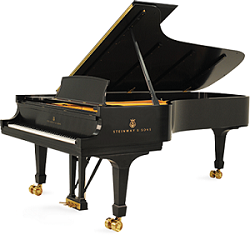Read Piano History Part One first.
Let’s continue discussing the history of the piano (short for pianoforte). We were talking about the piano of the the mid/late eighteenth century.
By the mid 18th century, Romanticism in the arts became all the rage and the piano’s popularity rose sharply. Romanticism encouraged the expression of emotions through art, and because of the piano’s expressive characteristics, musicians chose it over other instruments. Composers began composing more piano music and solo piano performances in concert halls were often sold out. One performer who is known for his extraordinary piano performances in front of hundreds of adoring females is Franz Liszt. By today’s standards he was what we would call a musical superstar.
As we’ve already seen in our discussion of piano history, the piano underwent tremendous inventions and improvements in its construction throughout the years. This gave rise to more sophisticated, more refined and subtle playing techniques. For instance, there were richer dynamics as a result of strings stretched diagonally in a sound box, which Loud did in 1802. Broadwood invented the metal frame in 1815. Erard introduced the double hopper and thicker strings in 1822. Pape substituted felt for leather on the hammers in 1826. In 1842, Pape increased the range of keyboard to eight octaves (Beethoven’s Streicher piano came with only six and a half octaves). Bord reinforced strings with a metal bar in the year, 1843. This increased their resistance to the hammer blows.
 As a result of all these innovations the mechanics of the piano was more balanced and responsive and the keyboard’s touch was improved. One great innovation was the double hopper. The double hopper permitted the rapid repetition of notes and better control of dynamics. The basic features of the piano as we know it today were established in 1859, with the first appearance of the Steinway concert grand piano.
As a result of all these innovations the mechanics of the piano was more balanced and responsive and the keyboard’s touch was improved. One great innovation was the double hopper. The double hopper permitted the rapid repetition of notes and better control of dynamics. The basic features of the piano as we know it today were established in 1859, with the first appearance of the Steinway concert grand piano.
The Americans played had their part to play in piano history. It was the Americans who brought the once expensive piano to the homes of middle-class families. The cost of pianos was significantly reduced, thanks to new assembly-line techniques and standardized piano parts. By the end of the 19th century, the instrument was a must-have for every household. It was very easy to store the piano at home, as a result of the functional upright design. There was really no excuse for not buying a piano, with pre-made piano parts made for easy assembly and mail-order catalogs with generous installment plans. The piano became very popular among women. Women were encouraged to learn to play the piano. A woman who could play the piano was perceived as a refined woman. Any woman who could play the piano, be a good cook and have needlepoint skills would find marriage in a flash. It was a great way for women to earn money through piano lessons.
During the 1920s, the piano was a hallmark for working class communities. According to the Smithsonian’s Piano 300 Exhibition in Washington DC, African-Americans had been using the piano in their gospel worship services since after the Civil War. Towards the beginning of the 20th Century, African Americans began to experiment with the instrument. New musical styles like ragtime and jazz were created by new composers such as Scott Joplin. These styles became the basis for American popular music in the latter half of the 20th century.
What impact did new inventions have on piano history
With the invention of the radio, phonograph and movie industry, the piano’s popularity was threatened. Piano sales fell in the Depression of the 1930s leading manufacturers to introduce player pianos. These player pianos were fed with music sheets resembling giant punch cards, which mechanically depressed the correct keys. Manufacturers, in an effort to stimulate interest in the piano, focused on economy and appearance as opposed to quality and performance. By the 1940s, baby grands and spinets were the piano models of choice among consumers and the same applies today.
In modern times the digital piano sells more than the grand piano (by far). Several factors contribute to this including the higher cost of grand pianos, the portability of digital pianos, and the presence of so many voices and features in digital pianos. However, one thing is for sure and it’s that piano playing and piano music is not going away. The piano is one of the most popular instruments today along with the guitar.
If you’re learning to play the piano or you want to improve your piano playing skills, you’re in the right place. Go here to check out our free piano lessons.
Here’s our number one recommendation on this site for learning to play piano.
Return to history of the Piano, part one.
Return from Piano History to home page.